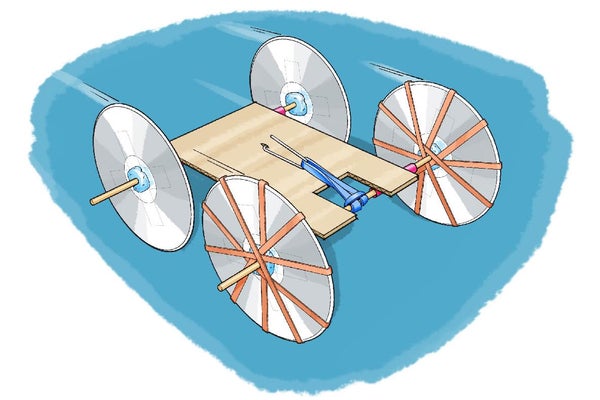

Key concepts
Physics
Potential energy
Kinetic energy
Conservation of energy
Simple machine
Introduction
Admit it, you’ve probably launched a rubber band at least once—pulled one end back, and let it go flying. Did you ever suspect that rubber bands could also be a fun way to learn about physics and engineering? Find out in this project where you’ll build a rubber band–powered car.
Background
When you stretch a rubber band it stores potential energy. Specifically it stores elastic potential energy—the type of energy stored when a material is deformed (as opposed to gravitational potential energy, the type you get when you raise an object off the ground). When you release it all, that stored energy has to go somewhere. If you launch a rubber band across the room, the potential energy is converted to kinetic energy, the energy of motion.
If you're enjoying this article, consider supporting our award-winning journalism by subscribing. By purchasing a subscription you are helping to ensure the future of impactful stories about the discoveries and ideas shaping our world today.
But what about putting all that stored energy to use? You can attach your rubber band to a simple machine—a wheel and axle—to build a simple rubber band–powered car. In real cars, gasoline’s chemical energy or the electrical energy in a battery is converted to kinetic energy of the moving car. Your model car will use a rubber band as the source of energy. It will take a little engineering to get your vehicle working—challenge yourself to see how far your car can go!
Materials
(Note: This is an engineering design project. The following is a suggested list of materials, but you can substitute different ones.)
Preparation
Observations and results
When you wind up the car’s axle you stretch the rubber band and store potential energy. When you release it the rubber band starts to unwind, and the potential energy is converted to kinetic energy as the car is propelled forward. The more you stretch the rubber band, the more potential energy is stored, and the farther and faster the car should go.
That all sounds great in theory—but in practice you might have found it difficult. Several things can prevent your car from working well. If the wheels are not aligned properly, they can wobble or jam and prevent the car from rolling smoothly. The rubber band can slip relative to the wooden axle, preventing the wheels from spinning. Even if the wheels do spin, there might not be enough friction with the ground, causing them to spin in place without moving the car. These are all challenges you can overcome with a little engineering effort!
More to explore Build a Balloon-Powered Car, from Scientific American Balloon-Powered Car Challenge, from Science Buddies
Snappy Science: Stretched Rubber Bands Are Loaded with Potential Energy!, from Scientific American Absorb the Shock!, from Scientific American Science Activities for All Ages!, from Science Buddies
This activity brought to you in partnership with Science Buddies